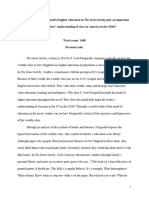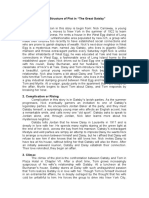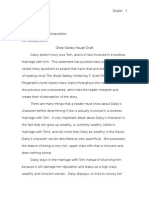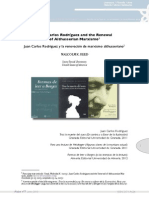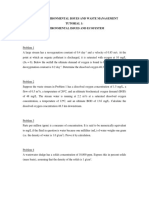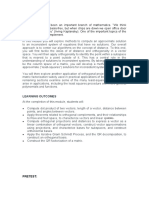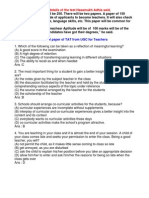The Great Gatsby - Critique of American Upper Class Values
The Great Gatsby - Critique of American Upper Class Values
Uploaded by
medaksbdCopyright:
Available Formats
The Great Gatsby - Critique of American Upper Class Values
The Great Gatsby - Critique of American Upper Class Values
Uploaded by
medaksbdOriginal Title
Copyright
Available Formats
Share this document
Did you find this document useful?
Is this content inappropriate?
Copyright:
Available Formats
The Great Gatsby - Critique of American Upper Class Values
The Great Gatsby - Critique of American Upper Class Values
Uploaded by
medaksbdCopyright:
Available Formats
The Great Gatsby | Critique of American Upper Class Values
This essay examines the upper class myths of lineage, institutional education, manners,
and wealth. Fitzgerald uses The Great Gatsby’s central conflict between Tom Buchanan
and Jay Gatsby to illustrate his critique of American upper class values.
The Great Gatsby is known as the quintessential novel of the Jazz age. It accurately
portrays the lifestyle of the rich during the booming 1920s. Readers live vicariously
through the lavish parties and on the elegant estates. Romantics relate to Gatsby’s
unrelenting commitment to Daisy, the love of his life. But beneath all the decadence and
romance, The Great Gatsby is a severe criticism of American upper class values.
Fitzgerald uses the book’s central conflict between Tom Buchanan and Jay Gatsby to
illustrate his critique. Tom is the incarnation of the upper class, Gatsby the nouveau
riche. The contrast between them demonstrates the differences between the values of
their respective classes. In this essay we will examine the upper class myths of lineage,
institutional education, manners, and wealth. One by one, Fitzgerald strips away the
illusion of superiority to reveal the ugly truth behind the glittering façade of the rich.
Myth #1: The Importance of Lineage
For the “old” (inherited) money crowd, family lineage is often the first, and perhaps most
important, indicator of class rank. This theme runs through the entire novel. Tom’s old
Chicago family is “enormously wealthy.” In fact, “his position” was what attracted Daisy
to him. And he adamantly argues his racial superiority during the opening scene. But his
lineage does not translate into anything worthwhile. The Buchanans never see their
families. The core of their own family, their marriage, is a shambles—Tom cheats and
Daisy’s miserable. And their daughter seems irrelevant to their lives.
Gatsby, one the other hand, is of unknown background. Rumors circulate that he is
related to everyone from the Kaiser to Satan. Eventually we learn that Gatsby comes
from a humble, midwestern family. He grew up poor. Ironically, the Gatsby (or Gatz)
family provides the only examples of familial love. We learn that Gatsby bought his
father a house, and his father cannot hide his emotion, his affection, and his admiration
for his son in the final chapter.
Myth #2: The Importance of Institutional Education
Institutional education—where you go to school—holds an important place in class
structure. Nick points out that he, his father, and Tom Buchanan attended New Haven,
the discreet name for Yale, an institution that ranked with Harvard and Princeton as the
school of the elite. However, Tom’s attendance at one of the nation’s finest universities
does little to develop his “simple mind.” At one point he even admits to being “pretty
dumb.” His crude attempts at intellectualism, for example his “scientific” explanation of
the decline of civilization caused by “The Rise of the Colored Empires,” only serve to
reveal a dangerously thin understanding of the world.
By contrast, Gatsby’s claim to institutional learning is sketchy. Whether or not Gatsby is
a true “Oxford man” recurs throughout the story as a source of controversy. In fact, Tom
considers a major victory Gatsby’s revelation that his affiliation with the prestigious
English school was only temporary. But despite his lack of formal education, we
understand Gatsby to have a focused, intelligent mind. He literally pulls himself up from
poverty to the heights of wealth through discipline and brains.
Myth #3: The Importance of Manners
Savoir faire, knowing what to do, and good manners, are qualities often attributed to the
upper class. In fact, some elitists believe that this is how well-bred people distinguish
themselves from others. Ironically, the most “well-bred” characters in the novel are often
the worst behaved. Tom is the best example. Despite his breeding, he is abrupt,
constantly rude, and even violent. In Chapter 2, he breaks his lover’s nose when she
annoys him—an impolite action even in the most philistine circles.
Here again, manners highlight the difference between the classes. The low-born and self-
made Gatsby is always the perfect gentleman. Even when his rival, Tom, stops by with
his two snooty friends, he maintains his impeccable hosting ethic. And while his manners
may come off as too stiff and formal, he is nonetheless portrayed as kind and considerate
throughout. The narrator, Nick, goes so far as to call his gestures “gorgeous.”
Myth #4: The Importance of Wealth
The fourth myth associated with the upper class involves the preeminence of wealth.
Fitzgerald goes to great lengths to describe Tom’s tremendous wealth, his estate, his cars,
his polo ponies. But Tom’s wealth comes off as worthless. He is mean and stingy, and we
never see him share his unearned fortune. In fact, it’s just the opposite. He denies the
impoverished George Wilson one of his extra cars, despite Wilson’s desperate pleas.
On the contrary, the newly rich Gatsby spends his money freely. Stories of Gatsby’s
generosity abound. He provides food, drinks, entertainment, and even shelter to hundreds
of people, even those he did not invite. In one instance, he replaced a guest’s expensive
evening gown that she accidentally tore at one his parties. And unlike Tom, who receives
money from his family, Gatsby generously gives money to his aging father.
By establishing the conflict between Tom and Gatsby, Fitzgerald mirrors the conflict
between the upper and upwardly-aspiring classes in America. Fitzgerald’s
characterizations and the narrator’s commentary criticize the rich throughout the book.
Tom Buchanan, with his lineage, education, breeding and wealth, epitomizes the upper
class. But by the end of the story, we realize that these qualities are empty. In one
sweeping condemnation, Nick proclaims to Gatsby, “They’re a rotten crowd.… You’re
worth the whole bunch put together” (154,; ch. 8). Fitzgerald finally and skillfully
destroys the upper class claim to superiority.
Work Cited
Fitzgerald, F. Scott. The Great Gatsby. New York: Scribner Paperback Edition, 2004.
You might also like
- The Great Summary and Analysis of The Great GatsbyDocument27 pagesThe Great Summary and Analysis of The Great GatsbyJoshua Aaron SolomonNo ratings yet
- The Theme of Power and Privilege in The Great GatsbyDocument2 pagesThe Theme of Power and Privilege in The Great Gatsbytofumofu100% (3)
- The Great Gatsby AnalysisDocument5 pagesThe Great Gatsby Analysisapi-256921267No ratings yet
- Codan 8525B Arduino VFODocument10 pagesCodan 8525B Arduino VFODock FahroNo ratings yet
- Crazy Eddie IncDocument10 pagesCrazy Eddie IncrianNo ratings yet
- Group 2 4620 Group ReportDocument15 pagesGroup 2 4620 Group ReportAtitat Rattanachata100% (1)
- The Great Gatsby ThemesDocument5 pagesThe Great Gatsby Themesanuuus445No ratings yet
- The theme of decay in The Great Gatsby - Essay 2 - Dương Anh ThưDocument3 pagesThe theme of decay in The Great Gatsby - Essay 2 - Dương Anh Thưthaolee1313No ratings yet
- Great-Gatsby-Marxist-Reading (1)Document3 pagesGreat-Gatsby-Marxist-Reading (1)Herson VardeNo ratings yet
- The Great Gatsby Is A Best Time Selling Novel Written by F. Scott Fitzgerald. The NovelDocument5 pagesThe Great Gatsby Is A Best Time Selling Novel Written by F. Scott Fitzgerald. The NovelOmotunde AlabiNo ratings yet
- Gatsby EssayDocument2 pagesGatsby EssayDaniel MaoNo ratings yet
- Jelica Jane Novel ReviewDocument10 pagesJelica Jane Novel ReviewBelinda MorataNo ratings yet
- In The Great GatsbyDocument8 pagesIn The Great GatsbyEthanNo ratings yet
- Gatsby HLE 5 5 5 5Document5 pagesGatsby HLE 5 5 5 5alp durgunNo ratings yet
- Comparative EssayDocument3 pagesComparative EssayShayne Rebello100% (1)
- The Great Gatsby 1Document78 pagesThe Great Gatsby 1Alex Roman BarberNo ratings yet
- Bookreportq3 2016-JolinasantosDocument2 pagesBookreportq3 2016-Jolinasantosapi-302911087No ratings yet
- Great Gatsby Essay 2024 Kw4Document12 pagesGreat Gatsby Essay 2024 Kw4Jana KotzeNo ratings yet
- The Great Gatsby EssayDocument6 pagesThe Great Gatsby Essayalyy_kay7No ratings yet
- Madeline Hopwood - Final DocumentDocument10 pagesMadeline Hopwood - Final Documentapi-692338690No ratings yet
- UntitledDocument5 pagesUntitledmarigold_rose2050100% (1)
- The Great Gatsby The American Dream ThesisDocument8 pagesThe Great Gatsby The American Dream ThesisNathan Mathis100% (2)
- Higher Level Essay:: HL Essay Example C: Student WorkDocument3 pagesHigher Level Essay:: HL Essay Example C: Student WorkGavin Donnelly100% (1)
- The Great GatsbyDocument18 pagesThe Great GatsbyJovanaSimijonovićNo ratings yet
- The Great Gatsby ReviewDocument6 pagesThe Great Gatsby ReviewMoon CalledNo ratings yet
- The Great Gatsby Vs The Sound and The FuryDocument4 pagesThe Great Gatsby Vs The Sound and The FuryMelissa FoxNo ratings yet
- ElagreatgatsbyDocument5 pagesElagreatgatsbyapi-355163163No ratings yet
- The Great GatsbyDocument22 pagesThe Great Gatsbyshikh.saad1615No ratings yet
- Aml 3051 Final PaperDocument7 pagesAml 3051 Final Paperapi-302494669No ratings yet
- ThegreatgatsbyessayDocument3 pagesThegreatgatsbyessayapi-333130578No ratings yet
- Vanity Fair and The Great Gatsby Tom Durant A level.202747158Document8 pagesVanity Fair and The Great Gatsby Tom Durant A level.202747158Amy NguyễnNo ratings yet
- The Structure of Plot in "The Great Gatsby" 1. ExpositionDocument8 pagesThe Structure of Plot in "The Great Gatsby" 1. ExpositionRenelyn Rodrigo SugarolNo ratings yet
- Characetrs Analysis: Jay GatspyDocument6 pagesCharacetrs Analysis: Jay GatspyummffzNo ratings yet
- Great Gatsby EOS RevisionDocument5 pagesGreat Gatsby EOS RevisionAHMED REDA YOUSSEF ELSAYEDNo ratings yet
- Jazmine Jones - Literary Analysis Final DraftDocument7 pagesJazmine Jones - Literary Analysis Final Draftapi-605042741No ratings yet
- Summary of The Great GatsbyDocument2 pagesSummary of The Great Gatsbyhtownapts1No ratings yet
- Some Randos Named Jfjiaiwdiajdwiawjd Essay On GatsbyDocument2 pagesSome Randos Named Jfjiaiwdiajdwiawjd Essay On GatsbywirsdudabispxsiaxdNo ratings yet
- The-Great-Gatsby-GradeSaver ProjectDocument4 pagesThe-Great-Gatsby-GradeSaver ProjectKayan SniperNo ratings yet
- The Great Gatsby SettingDocument4 pagesThe Great Gatsby SettingRocco Gilberto100% (1)
- Great Gatsby Course WorkDocument7 pagesGreat Gatsby Course WorkAtekkaNo ratings yet
- Copia de LIMPIO (Recuperado Automáticamente)Document13 pagesCopia de LIMPIO (Recuperado Automáticamente)Miry García GarcíaNo ratings yet
- Gatsby Setting EssayDocument2 pagesGatsby Setting Essaygiledidana123No ratings yet
- Book Review " THE GREAT GATSBY "Document5 pagesBook Review " THE GREAT GATSBY "sayemNo ratings yet
- Q1 How Do Tom and Daisy Represent The Morality of The EstablishedDocument6 pagesQ1 How Do Tom and Daisy Represent The Morality of The EstablishedShowket IbraheemNo ratings yet
- The Great Gatsby Students' EditionDocument22 pagesThe Great Gatsby Students' EditionSouad El-souqiNo ratings yet
- Essay - The Great GatsbyDocument7 pagesEssay - The Great Gatsbyapi-672762891No ratings yet
- The Great Gatsby AnalysisDocument4 pagesThe Great Gatsby AnalysisJuan Pablo González100% (3)
- 2020 Socratic QuestionsDocument5 pages2020 Socratic Questionsmyimadrid7No ratings yet
- Great Gatsby Final DraftDocument10 pagesGreat Gatsby Final Draftapi-287044316No ratings yet
- Great Gatsby Research Paper Final Draft (2015 01 04 23 28 30 Utc)Document16 pagesGreat Gatsby Research Paper Final Draft (2015 01 04 23 28 30 Utc)api-224938251No ratings yet
- The Great Gatsby Study NotesDocument4 pagesThe Great Gatsby Study NotesJesse100% (2)
- Gastby Essay Harley JeanDocument4 pagesGastby Essay Harley JeanHarley JeanNo ratings yet
- Great Gatsby AnalysisDocument37 pagesGreat Gatsby AnalysisSabrina DanisaNo ratings yet
- Bookreportq2 2015-MaiyaharperDocument3 pagesBookreportq2 2015-Maiyaharperapi-302704369100% (1)
- The Feminist Elements in The Great GatsbyDocument2 pagesThe Feminist Elements in The Great Gatsbyvkbts19951997No ratings yet
- The Great Gatsby (Themes, Motifs, Symbols,)Document12 pagesThe Great Gatsby (Themes, Motifs, Symbols,)Damian Alejandro SalinasNo ratings yet
- Critical Statements About 'The Great Gatsby'Document7 pagesCritical Statements About 'The Great Gatsby'JhelReshel CubillanTelin II100% (1)
- Great Gatsby - Acquisition of Wealth EssayDocument2 pagesGreat Gatsby - Acquisition of Wealth EssaywhatyouvetakenNo ratings yet
- Q3 W6 HW WritingDocument3 pagesQ3 W6 HW Writingyoussefmsamir2050No ratings yet
- Document 54 (2)Document6 pagesDocument 54 (2)Laraib AamirNo ratings yet
- 1 139877 What Makes TheDocument6 pages1 139877 What Makes TheAsad BilalNo ratings yet
- Killing and Rescuing: Why Necessity Must Be Rethought: Kieran ObermanDocument31 pagesKilling and Rescuing: Why Necessity Must Be Rethought: Kieran ObermanmedaksbdNo ratings yet
- The Rights of Nature, The Rights of Fiction: Mario Vargas Llosa and The AmazonDocument24 pagesThe Rights of Nature, The Rights of Fiction: Mario Vargas Llosa and The Amazonmedaksbd100% (1)
- Been Awarded.: Privacy Notice Page Data Protection PolicyDocument4 pagesBeen Awarded.: Privacy Notice Page Data Protection PolicymedaksbdNo ratings yet
- Nonpapers TemplateDocument24 pagesNonpapers TemplatemedaksbdNo ratings yet
- "Is An Archive Enough?": Megatextual Debris in The Work of Rachel Blau DuplessisDocument27 pages"Is An Archive Enough?": Megatextual Debris in The Work of Rachel Blau DuplessismedaksbdNo ratings yet
- Emily - Nacol@utoronto - Ca: Mily AcolDocument11 pagesEmily - Nacol@utoronto - Ca: Mily AcolmedaksbdNo ratings yet
- Christopher J. Lebron: Clebron2@jhu - EduDocument11 pagesChristopher J. Lebron: Clebron2@jhu - EdumedaksbdNo ratings yet
- Matthew Karp: Cademic PpointmentsDocument7 pagesMatthew Karp: Cademic PpointmentsmedaksbdNo ratings yet
- A Contested Presence: Portuguese New Christians in The Spain of Philip IV, 1621-1632 Yonatan Glazer-EytanDocument41 pagesA Contested Presence: Portuguese New Christians in The Spain of Philip IV, 1621-1632 Yonatan Glazer-EytanmedaksbdNo ratings yet
- Afsoun Afsahi, PHD: Research InterestsDocument9 pagesAfsoun Afsahi, PHD: Research InterestsmedaksbdNo ratings yet
- Eresa Ejan: Teresa - Bejan@politics - Ox.ac - UkDocument15 pagesEresa Ejan: Teresa - Bejan@politics - Ox.ac - UkmedaksbdNo ratings yet
- Public Philosophy in A New KeyDocument383 pagesPublic Philosophy in A New KeymedaksbdNo ratings yet
- Carlo Ginzburgian - Great TextsDocument245 pagesCarlo Ginzburgian - Great Textsmedaksbd100% (1)
- Juan Carlos Rodríguez and The Renewal of Althusserian MarxismoDocument24 pagesJuan Carlos Rodríguez and The Renewal of Althusserian MarxismomedaksbdNo ratings yet
- Shubh Draft PDFDocument58 pagesShubh Draft PDFShubh MehrotraNo ratings yet
- Turok Evolution Prima Official EguideDocument120 pagesTurok Evolution Prima Official Eguidearturo2013No ratings yet
- Tutorial 1Document2 pagesTutorial 1SITI NADHIRAH AzmiNo ratings yet
- Lesson Plan - Shakespeare TableauxDocument8 pagesLesson Plan - Shakespeare TableauxXuan HanNo ratings yet
- Ashok Singh Topic 3Document9 pagesAshok Singh Topic 3Insta viralNo ratings yet
- Loans and Savings Management System For Bentuco National High School Faculty CooperativeDocument7 pagesLoans and Savings Management System For Bentuco National High School Faculty CooperativeInternational Journal of Innovative Science and Research TechnologyNo ratings yet
- Hospital Experiences Responding To The COVID-19 PandemicDocument41 pagesHospital Experiences Responding To The COVID-19 PandemicLaw&CrimeNo ratings yet
- 3F Filippi General Catalogue Led 2020.3-EN PDFDocument624 pages3F Filippi General Catalogue Led 2020.3-EN PDFMircea MiNo ratings yet
- LogDocument202 pagesLogpiratemrshockNo ratings yet
- Registration Preview: Anna University:: Chennai 600025 Application For Nov. / Dec. Examination, 2023 ExaminationDocument64 pagesRegistration Preview: Anna University:: Chennai 600025 Application For Nov. / Dec. Examination, 2023 ExaminationRajamanikkam RajamanikkamNo ratings yet
- Madhav Institute of Technology & Science, Gwalior: Examination Admit Card (Eac)Document1 pageMadhav Institute of Technology & Science, Gwalior: Examination Admit Card (Eac)Rohan MalakarNo ratings yet
- QBM101Document37 pagesQBM101Shang BinNo ratings yet
- Johanna Marcela Velasco: Address: English-SpanishDocument2 pagesJohanna Marcela Velasco: Address: English-SpanishpaolaNo ratings yet
- Planning in ManagementDocument22 pagesPlanning in ManagementAnna TongcoNo ratings yet
- QP02Document11 pagesQP02zakwanmustafa0% (1)
- Error SpottingDocument3 pagesError SpottingselvambhrNo ratings yet
- Orthogonal ComplementDocument6 pagesOrthogonal ComplementmalynNo ratings yet
- Arrest How MadeDocument19 pagesArrest How MadeNARANJA DIZZA MAKAKENANo ratings yet
- ATR4517R5-1929 DatasheetDocument2 pagesATR4517R5-1929 DatasheetVíctor RomeuNo ratings yet
- Model Paper of TAT From UGC For Teachers: Giving Details of The Test Hasamukh Adhia SaidDocument22 pagesModel Paper of TAT From UGC For Teachers: Giving Details of The Test Hasamukh Adhia Saidshailesh5180No ratings yet
- Information Management Systems, ObstetricalDocument12 pagesInformation Management Systems, ObstetricalLee ThoongNo ratings yet
- Safety Suite Device Configurator-BrochureDocument4 pagesSafety Suite Device Configurator-BrochurePapaney VWNo ratings yet
- Hindu ScripturesDocument32 pagesHindu ScripturesRaaj Gupta100% (2)
- Coast Artillery Journal - Feb 1936Document83 pagesCoast Artillery Journal - Feb 1936CAP History LibraryNo ratings yet
- UncletomscabinDocument3 pagesUncletomscabinapi-286227921No ratings yet
- Loadcell Transmitter PF-LBPDocument2 pagesLoadcell Transmitter PF-LBPhari mulyonoNo ratings yet
- (Re) Animating The Horror Genre - Explorations in Childrens AnimatDocument215 pages(Re) Animating The Horror Genre - Explorations in Childrens AnimatYop YoNo ratings yet













